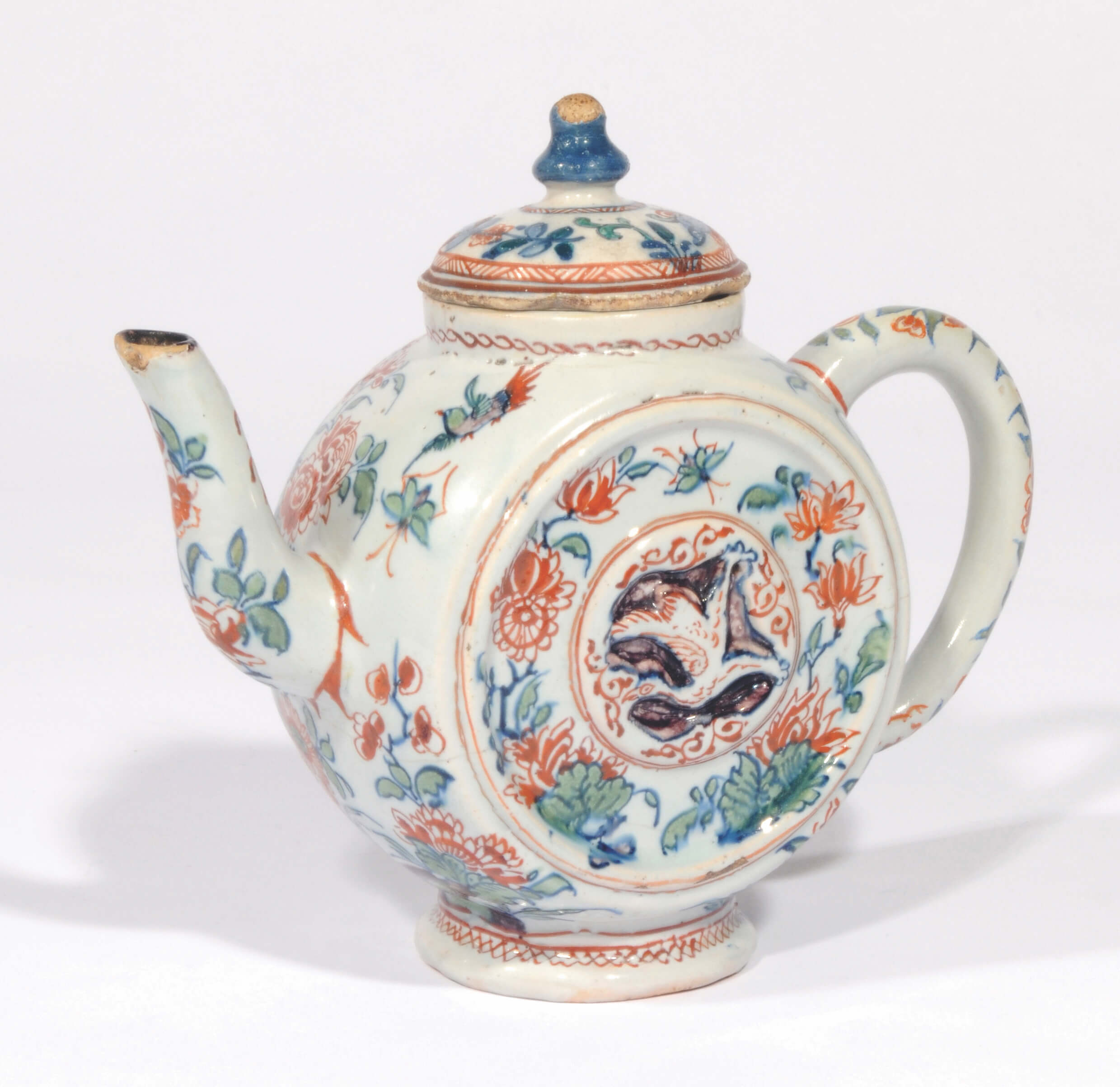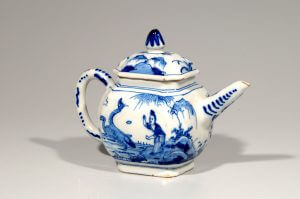
Fancy a Cup of Tea?
The Dutch East India Company (VOC) found in the faraway lands that they visited many treasures and commodities, that were uncommon at that time in the Netherlands. Besides the popular and desired import commodity Chinese porcelain, Asia’s botanical imports were arguably even more widely enjoyed, and had a greater economic impact than did any of the durable commodities. Tea was one of these interesting finds, and not only the VOC but also its British counterpart, the so-called British East India Company shipped it to their country. Already in the sixteenth century Europeans knew about the existence and the habit of tea drinking in China by the accounts of travelers as the Portugese Caspar da Cruz (circa 1520- 1570) or the Dutchman Jan Huygen van Linschoten (circa 1563 – 1611). Although several sources say that tea was imported in small quantities throughout the century from both China and Japan, others say that the production in Japan was only meant for its own population, and not for export.
 Initially drinking tea in Europe had a medicinal purpose, since it “suivert het grove bloedt, verdrijft de sware droomen, (…) ’t verjaegt de dommigheijt en ’t sterckt Venus’ handel (gedienstig voor nieuw getrouwde)” (“purifies coarse blood, drives out heavy dreams, (…) chases away stupidity and strengthens Venus’ affairs (useful for newly weds)”.[1] It took a while though before the fashion became generally established, but in the last quarter of the seventeenth century, the craze for tea drinking began to sweep through Europe.
Initially drinking tea in Europe had a medicinal purpose, since it “suivert het grove bloedt, verdrijft de sware droomen, (…) ’t verjaegt de dommigheijt en ’t sterckt Venus’ handel (gedienstig voor nieuw getrouwde)” (“purifies coarse blood, drives out heavy dreams, (…) chases away stupidity and strengthens Venus’ affairs (useful for newly weds)”.[1] It took a while though before the fashion became generally established, but in the last quarter of the seventeenth century, the craze for tea drinking began to sweep through Europe.
The Chinese word for the hot beverage, ‘tê’, was now adapted to ‘thee’ in the Netherlands, ‘tea’ in the United Kingdom, ‘thé’ in France and ‘tee’ in Germany[2] , and by 1680 “taking tea” was widespread amongst the Dutch households.[3] Chinese tea would go on to become one of the most profitable trade commodities for the VOC in the eighteenth century. In contrast to today, most tea drunk in the 17th and 18th century was green tea, ‘hyson’, and olong (black smoked) tea, ‘bohea’. The heavily fermented tea, as is so famous today as English tea, was yet to be invented, being a legacy from British tea production in colonial India in the nineteenth century.[4]
When the practice became fashionable, it changed the rhythm of people’s daily lives. Tea could be drunk once or twice a day, but afternoon gatherings became the new habit. Furthermore it inspired people to acquire the necessary accoutrements for serving the drink. In the seventeenth century, these necessities could be of a variety of materials, sometimes Chinese and European tea ware were combined, but by the end of the eighteenth century, it was customary to have complete matching sets. Tea was presented to the guests in beautifully tea canisters, after which in small pots strong brews of tea were made from the teas of choice. These concentrated brews were then diluted with hot water from a bouilloire, a silver, copper (although this material was thought not so suitable for boiling water) or pewter kettle on a stand over a brazier.[5] Bouilloires were also executed in Delftware, but they are very rare. When the guest wanted to try a different kind of tea, he or she could rinse the cup in the slop bowl. The new drink should be sipped as hot as possible, but if too hot, it could be poured on the saucer to cool a little and sipped from there. With tea being very expensive, the cups were small, so it was not uncommon if one would have up to twenty or even fifty cups during a tea party. To indicate one had had enough, the cup was placed upside down on the saucer.[6] This habit is lovely illustrated in the painting Still Life with Tea by Etiènne Liotard, from around 1781-1783, and now in the collection of the J. Paul Getty Museum, Los Angeles. It shows a famille rose China tea service, and a dish of bread or toast with butter.
The utensils had to withstand the high temperatures of boiling water and every day usage, and the strong and thin porcelain became in high demand for drinking tea. In 1637 for example, the VOC ordered 25,000 teacups from China, in order to provide the new tea-drinkers with suitable equipment.[7] In 1644, the numbers of imported Chinese examples were even extended to 60,000 round tea cups and 14,000 octagonal tea bowls![8] Other necessities considered were small tables to serve the tea, and in Holland a special type became standard: it had an oval top, column shaped stand on a three-legged base.
 It was around 1680 that the low, horizontal teapot that we know today was developed in Europe from the Chinese porcelain wine ewer.[9] The Dutch potters also produced several teapots. A blue and white example, produced around circa 1735 in the city of Delft, shows directly the influences from the Chinese porcelain wares. It is decorated in an underglaze blue with a chinoiserie decor of a Long Eliza feeding the ducks, and the straight tapered spout and loop handle with stripes, dots and squiggles. Also colored teapots, such as this teapot executed in the so-called ‘cashmire palette’, consisting of red, blue and green, were created by the Delft factories. Each side of this teapot is decorated with a phoenix in relief, against a manganese background, surrounded by floral decorations. Flowering branches decorate the body, the spout and the handle, and also the cover is delicately decorated. Both decoration and use of color are fitting perfectly into the fashion for the exotic at the time.
It was around 1680 that the low, horizontal teapot that we know today was developed in Europe from the Chinese porcelain wine ewer.[9] The Dutch potters also produced several teapots. A blue and white example, produced around circa 1735 in the city of Delft, shows directly the influences from the Chinese porcelain wares. It is decorated in an underglaze blue with a chinoiserie decor of a Long Eliza feeding the ducks, and the straight tapered spout and loop handle with stripes, dots and squiggles. Also colored teapots, such as this teapot executed in the so-called ‘cashmire palette’, consisting of red, blue and green, were created by the Delft factories. Each side of this teapot is decorated with a phoenix in relief, against a manganese background, surrounded by floral decorations. Flowering branches decorate the body, the spout and the handle, and also the cover is delicately decorated. Both decoration and use of color are fitting perfectly into the fashion for the exotic at the time.
Dutch Delftware teapots are rare, since vessels made from regular earthenware were comparably coarser than porcelain, and considered less elegant and pleasant to drink from. More important is the fact that earthenware is not the best material to hold boiling water. Heat is conducted more readily by earthenware, being a poreus material, than by porcelain, and it was prone to crack when it had to endure large temperature differences. When the glaze was crackled, the material underneath was not sealed anymore, and the water caused it to crumble. This was exactly the reason why the Delft potters began producing red stoneware pots, inspired by the red Chinese Yixing stoneware. This was a type of red stoneware that could withstand high temperatures. Often it was simply decorated in relief with some sprigs and flowers, or bamboo. As discussed in Delft Red Stoneware Teapots, only a few Delft potters succeeded in making a similar product.
Notes
[1] E.M. Jacobs, Koopman in Azië, De handel van de Verenigde Oost-Indische Compagnie tijdens de 18e eeuw, Zutphen, 2000, p. 137.
[2] Aronson Antiquairs, Dutch Delftware, Amsterdam 2008, p. 46.
[3] K. H. Corrigan, J. van Kampen, F. Diercks, Asia in Amsterdam, The culture of Luxury in the Golden Age, New Haven and Londen, 2015, p. 128.
[4] ‘Tea in eighteenth century Britain, History of tea Project’, Queen Mary University of London.
[5] E.B. Schaap, Delft Ceramics at the Philadelphia Museum of Art, Philadelphia 2003, p. 44.
[6] Aronson Antiquairs, Dutch Delftware, In the Eye of the Beholder, Amsterdam 2011, p. 56.
[7] H. Couts, The Art of Ceramics, European Ceramic Design 1500-1830, New Haven and London, 2001, p. 70-71.
[8] D.F. Lunsingh Scheurleer, Chine de Commande, Hilversum, 1966, p. 101.
[9] H. Couts, The Art of Ceramics, European Ceramic Design 1500-1830, New Haven and London, 2001, p. 71.
[10] Aronson Antiquairs, Dutch Delftware, In the Eye of the Beholder, Amsterdam, 2011, p. 56.



